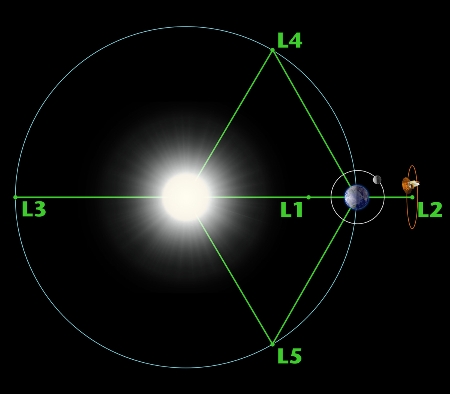Lagrange Points: Parking Places in Space
- A Lagrange point is a location in space where the combined gravitational forces of two large bodies, such as Earth and the sun or Earth and the moon, equal the centrifugal force felt by a much smaller third body.
- The interaction of the forces creates a point of equilibrium where a spacecraft may be "parked" to make observations.
- There are five Lagrange points around major bodies such as a planet or a star. Three of them lie along the line connecting the two large bodies

Lagrange Points
- The first point, L1, lies between Earth and the sun and gets an uninterrupted view of the sun and free from the occurrence of eclipses.
- India's Aditya Satellite is placed at L1 point.
- L2 with the Earth, moon and sun behind it, a spacecraft can get a clear view of deep space and it has a protection for radiation field from sun.
- The James Webb Space Telescope will move into L2 point in 2018.
- The third Lagrange point, L3, lies behind the sun, opposite Earth's orbit. For now, science has not found a use for this spot.
- Points L4 and L5 are stable and lie along Earth's orbit at 60 degrees ahead of and behind Earth and dust and asteroids tend to accumulate in these regions due to its stability.
- Asteroids that surround the L4 and L5 points are called Trojans and Earth’s only known Trojan asteroid, 2010 TK7 is found in the region.
Benefits of Lagrange points
- The Spacecraft at this point would be more sensitive to the tiny infrared signals from asteroids.
- The location would allow for natural cooling and would need any additional coolant to stay cool. The James Webb Space Telescope will take advantage of the thermal environment at the sun-Earth L2 point to help keep cool.
- L1 and L2 also has enormous bandwidth over conventional Ka-band radio and the communication speeds are very high.
Kamov 226T
- Hindustan Aeronautics Limited and Russian defence firms have finalized the Joint Venture agreement for collaboration in the production of light weight multi-role 'Kamov 226T' helicopters in India
- The Kamov 226T is a twin-engine light but multi-role chopper offers services for both military and civilian purposes.
- The helicopters will replace India's ageing fleet of Cheetah and Chetak.
- The military version of 226T is capable of working in extreme and difficult weather conditions. This includes hot climate, marine areas and high mountains.
- The Kamov 226T can be used effectively for reconnaissance, targeting and monitoring of transportation.
- The helicopter has a maximum speed of 250 km/hour and a cruise speed of 220 km/hour.
- The maximum takeoff weight of the helicopter is 3,600 kg.
